Lesson 50
Learning Objectives
By the end of this section, I should be able to answer these questions:
1. What are the two reasons for wearing an exposure suit?
2. What are the three primary types of exposure suits and how do they differ? Which type requires special training?
3. Why is fit particularly important with a wet suit?
4. What exposure suit options and accessories can I choose from?
5. Why is overheating sometimes an issue with exposure suits? How do I avoid overheating?
Exposure Suits I
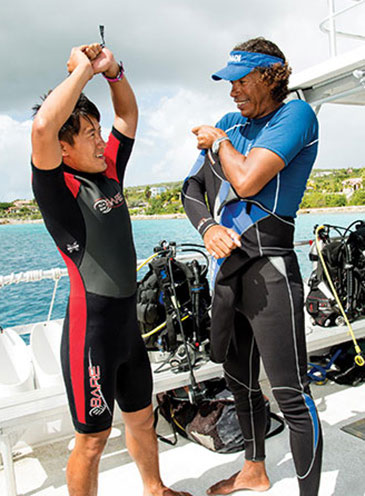
You wear an exposure suit on most dives for two main reasons: warmth, and/or protection against accidental stings, abrasions and cuts.
There are three primary exposure suit types: wet suits, dry suits and skin suits. Let’s look at how they differ, and where and when you’d use each.
Wet Suits
Wet suits are the most common exposure suits. This is because they provide insulation and protection, and also come in a wide variety of styles depending upon how much insulation you need. This makes them useful in water as cold as 10ºC/50ºF to as warm as 30ºC/86ºF.
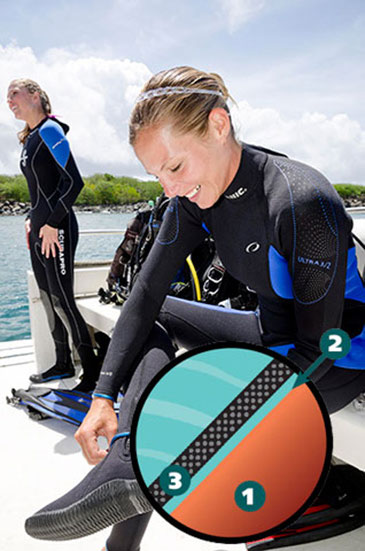
Wet suits insulate you with foam neoprene (or other insulating material), but you don’t stay dry. Water seeps into a wet suit around your wrists, ankles and neck and gets trapped. Your body (1) quickly heats the trapped water (2), and the neoprene (3) greatly slows heat loss.
To work, though, the suit must trap the water. If your suit is too loose, water flows in and out, carrying heat with it. If it’s too tight, it’s uncomfortable. Have a dive professional assist you with getting a proper fit when choosing a wet suit. You get the best fit with a custom wet suit made specifically for you.
Dry Suits
Dry suits provide the most insulation. As their name suggests, they keep you dry. They have special watertight zippers and seals, and most types cover your entire body, except your head and hands, which you protect with a wet suit hood and gloves. Dry suits used in the coldest water (like under polar ice) keep even your head and hands dry.

The air within the suit, as well as an undergarment and sometimes the dry suit itself (depending upon the material), provide insulation. This makes dry suits the most effective option for cooler water diving. They extend how long you remain comfortable in water cooler than about 18ºC/65ºF, and they’re the primary option for diving in water colder than 10ºC/50ºF.
Fermentum curae posuere, facilisis leo? Per arcu congue in aptent metus eleifend? Eget habitasse fusce. Praesent pharetra lobortis, vel egestas.
As mentioned earlier, a dry suit creates an air space. You must equalize this space as you descend, and vent air as you ascend to control your buoyancy. When diving in a dry suit, you use an inflator hose from your regulator to inflate it, and the suit’s exhaust valve to release expanding air as you ascend.
Dry suits do not have to fit as closely as wet suits, but sizing is still important. You can choose from a variety of materials, each with different characteristics and benefits. See your PADI Professional for guidance when choosing one. It is not difficult to use a dry suit, but because you have to equalize it and control your buoyancy with it, using one does require special instruction.
Ask your instructor about the PADI Dry Suit Diver course. If you’ll be using a dry suit during this course, your instructor will orient you to using dry suits during your confined water dives.
Skin Suits
Skin suits – also called body suits – provide little or no insulation. You wear them in comfortably warm water to protect you from minor cuts, scrapes, stings and sunburn. Normally made of a stretchy material like Lycra®, they should fit closely to avoid drag.
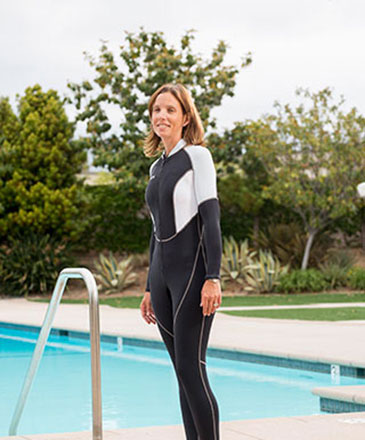
In moderately warm water, you may wear a skin suit under a partial wet suit. The wet suit provides enough insulation for a comfortable dive, while the skin suit provides protection for areas not covered by the wet suit. You may also find a skin suit makes it easier to put on a wet suit, because its material easily slides against the wet suit’s material.
Options and Accessories
Exposure suits have options and accessories depending upon the suit and where you use it. Your local PADI dive shop can help you sort through these based on your preferences and needs, but here are a few considerations:
Wet suits have the most styles and options. Multipiece suits give you layered insulation and versatility by letting you wear different pieces, or all of them, depending upon the temperature. “Shorty” wet suits cover your upper body and have short pant legs and sleeves. These are popular warm water suits.
Wet suits come in different thicknesses. Choose a thicker wet suit (5 or 7 mm neoprene) for more insulation. Thinner material (3 mm) is well suited to warmer water, and is less buoyant. In most styles and thicknesses, you can choose from a wide color variety, and options such as pockets, zipper location, knee pads, etc.
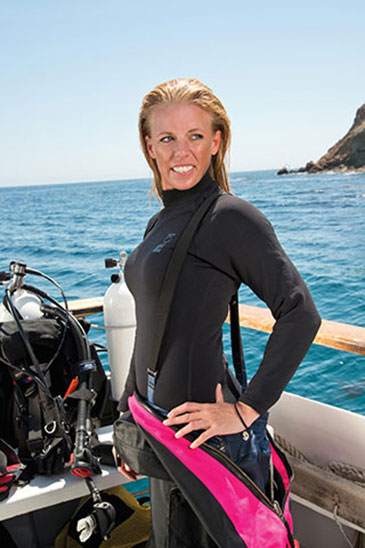
Dry suit options consist primarily of your choices of materials and undergarments. The dry suit materials you choose from offer advantages in terms of weight, durability and comfort.
You choose different undergarments depending upon the water temperature. You can use the same dry suit in a variety of temperatures, but with different undergarments. With most dry suits you wear a wet suit hood and gloves, but dry hoods and dry gloves are options for the coldest water
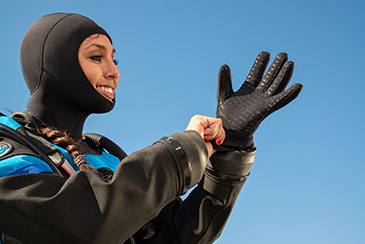
Hoods are important in water cooler than about 21ºC/70ºF for comfort, and because you lose a significant amount of heat through your head if it’s not insulated. This is true whether you’re diving in a wet suit or a dry suit, and for longer dives many divers wear a hood at warmer temperatures. A professional at your PADI dive shop can show you appropriate hoods.
When selecting a hood, or adjusting a dry suit neck seal, make sure it fits snugly, but not too tightly. If it’s too tight, it can restrict blood flow through your neck. This can cause light-headedness and, if you keep the hood or dry suit on, fainting and unconsciousness. Your PADI dive shop can help you choose the right size.
You wear gloves for warmth and for protection from cuts and stings, etc. In water colder than about 18ºC/65ºF, your fingers quickly become numb and lose dexterity without insulation. As the water gets colder, the choices, in order of increasing insulation, are: wet suit gloves, wet suit mitts (three finger) and dry gloves (on dry suits).
In warmer water, light “reef” gloves provide protection without sacrificing much dexterity. Some areas don’t allow divers to wear gloves while diving tropical reefs to discourage touching fragile coral.
You wear wet suit boots to protect and insulate your feet. You normally wear wet suit boots with open-heel fins, regardless of the temperature. They provide foot protection from the fins and when walking to and from the water. Fin socks are soft material you can wear under wet suit boots or with full-foot fins for further comfort. Dry suits usually have integrated boots.
Although most BCDs have pockets, many divers like pockets on their wet or dry suits. The most popular location is on the thigh, with zippered or VelcroTM-type closures so nothing falls out. Your PADI Dive Center or Resort can usually have pockets put on a wet or dry suit you already have.
Avoiding Overheating
Wet and dry suits are very effective insulators, so overheating can be an issue on a warm day especially before the dive. Your body can’t cool itself as effectively when you’re wearing an exposure suit, so be careful to avoid overheating.
- Set up the rest of your kit before putting on your exposure suit. Put your suit on at the last possible moment.
- Once in the suit, limit activity and stay out of the sun as much as you can.
- If you’re wearing a hood, pull it back until just before you put on your mask and enter the water. This helps you eliminate excess heat through your head.
- Leave the suit unzipped as long as possible.
If you start to overheat before or after a dive, take the time you need to cool off. Get in the water, have someone spray you with a hose (common on boats), or stop and take the suit partially or entirely off to avoid overheating problems.
Exposure Protection and Protecting the Environment
Because exposure suits reduce the risk of minor scrapes and stings, sometimes divers pay less attention to contact with coral, sponges and other fragile aquatic life. Unfortunately, while the diver may be protected, contact can injure or kill these organisms. While you wouldn’t intentionally kick, kneel on or bump into fragile creatures, exposure protection can make you less aware when you do it accidentally. In some environments, breaking a 25 cm/10 in piece of coral destroys a decade of growth. The following techniques help reduce incidental damage.
- Swim next to the reef rather than over it, to reduce fin damage. When you must swim over it, stay far enough above it to avoid fin contact.
- Stay neutrally buoyant with proper weighting and trim. Control your movements, and don’t swim with your feet low and your torso high – this makes it much easier to do damage with your fins and legs.
- Turn sideways when you look under a ledge. Your cylinder adds height to your profile; doing this reduces the likelihood of damage through cylinder contact.
- Keep all your gauges and hoses well secured and streamlined so they don’t drag.
- Remember that your exposure suit reduces but does not eliminate the possibility of aquatic life scrapes, stings or punctures. Sea urchin spines, for example, can penetrate many exposure suits. Avoiding contact with the reef and its inhabitants is the best way to reduce this risk.
- In general, avoid touching living organisms underwater. Doing so almost never benefits an organism, and seldom adds to the dive. For more about environmentally responsible diving, visit projectaware.org and download 10 Tips for Divers to Protect the Ocean Planet.
Quick quiz
Module Two

I'll take you diving!
Copyright © Larry Wedgewood Scuba Instruction All Rights Reserved

